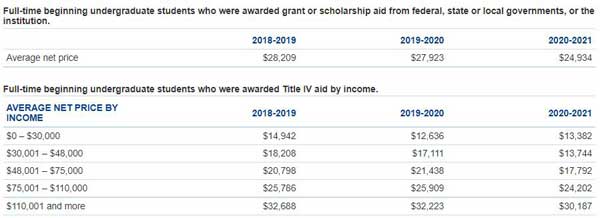 If you want to make a better college list, don’t limit your potential list of colleges to just schools you have heard of. There are over 1,600 four-year US colleges-there is no reason to start off with a short list of five institutions. Having a larger list of colleges opens up opportunities you haven’t even considered at prices you didn’t think possible.
If you want to make a better college list, don’t limit your potential list of colleges to just schools you have heard of. There are over 1,600 four-year US colleges-there is no reason to start off with a short list of five institutions. Having a larger list of colleges opens up opportunities you haven’t even considered at prices you didn’t think possible.
You need to think about having two college lists. The first is the list you start with. The second is the list of colleges you end up with and actually apply to. Your starter list should contain at least 20 schools, more if you have the time to research them. When you’re just starting, your college list should include colleges that you haven’t considered or heard of before you started creating the list.
So how do you find colleges you have never heard of?
Start with your “dream school”
This is the time to be open to new ideas. Pick or imagine your ideal school in every aspect. Go all out and assume you have a full scholarship to attend.
Next, start playing “what if” with the characteristics of this dream school. Would you go if it were 500 miles away? What if it was significantly smaller than you wanted? Or maybe it doesn’t have the big-time college sports you’re looking for? If just one of these factors was missing, would you still attend if you had a full scholarship?
If you would still consider going than you need to realize that these “requirements” you have already created are probably limiting some very good schools from your list. You can start expanding your list by taking one college you’re interested in and changing or removing a limiting characteristic to find similar schools.
For example, say you are interested in big universities with finance majors in the northeast. Start by changing finance to business or economics in general. What schools does that add to your list? Or maybe keep the finance part but add the mid-west or change big to medium-sized.
Ultimately, these new schools may not stay on your list. However, it’s more likely that you will discover possibilities that you hadn’t considered and revise the criteria for your list. Finances may still be critical but you might decide that there can be mitigating circumstances as far as size goes.
How to find colleges for your list
Here are six things you can do to expand your college list.
1. Ignore geography.
By this I mean both location, such as state, and place, such as rural. There are a lot of preconceived notions about colleges based on geography alone. Ultimately, geography may be an important consideration for narrowing your list of colleges. But by keeping geography out of the equation to begin with, you may discover other factors that more than make up for being in a place you had thought was less than desirable.
2. Don’t use rankings to keep colleges off your list.
Rankings are arbitrary, one person’s top ten may not make it to another person’s top 50. If and when you do use rankings to narrow your college list, be sure to understand the basis for the rankings. Most rankings are based on inputs, including what the students bring to the college. Ideally, families should be evaluating colleges based on what they will do for the students.
3. Look up similar colleges at CollegeResults.org.
If you know of a school that you really like, look it up to see 25 other schools that collegeresults.org considers similar. As when using the rankings, it is a good idea to see how they determine similar colleges. However, it’s a fast and easy way to expand your horizons.
I suggest CollegeResults rather than something like Big Future since Big Future relies on what other students are looking at. There really isn’t any indication that students who look at the same college you do are likely to break out of the group think and consider colleges you haven’t.
4. Your college list should focus on net cost rather than tuition.
Few people pay full price. You can get an even better idea of net price by income level by using the College Navigator. Make sure you have already calculated an estimated EFC and use the colleges’net price calculators. Be careful about using the information on the highest income category. Data are only available for those that receive some form of federal aid, including student loans.

5. Instead of acceptance rates, look at the 75th percentile test scores.
Admission rates often reflect a lot of self-selection not to mention rankings popularity so try a different approach. Even with test optional, many schools are still reporting tests scores which can be useful in targeting colleges. For example, there are 116 institutions where the 75th percentile ACT scores is between 30 and 31. The acceptance rates range from 32% to 94%. There are 49 colleges with acceptance rates between 30 and 40 percent and the 75th percentile ACT scores range from 19 to 34.
Keep in mind that with more schools being test-optional, the test scores that are being reported tend to be higher than before test-optional. Basically, people are only reporting really good test scores. Your test scores might be slightly lower than the 75th% and your application can still be competitive. Another thing to pay attention to is the percentage of students reporting test scores. This will give you some idea of how representative the scores are.
6. Don’t use college size in making your preliminary college list.
This is another area where many students have assumptions that they haven’t really tested. Make sure students visit colleges of all kinds of sizes before setting any size requirements. Ultimately, it’s simply a matter of numbers since there are just a lot more smaller colleges than bigger ones. Begin by looking at the percentage of classes by class size or the number or type of classes available for specific majors.
Information on geography, size, graduation rates, acceptance rates, test scores, majors, and more are available in the DIY College Rankings College Search Spreadsheet.
CONNECT WITH OTHER PARENTS PLANNING FOR COLLEGE
JOIN THE COFFEE CUP COLLEGE PLANNING FACEBOOK GROUP



9 thoughts on “6 Tips for Making a Better College List”